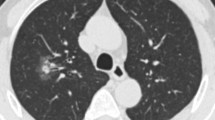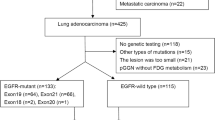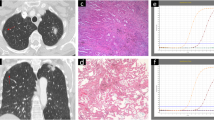Abstract
Objectives
To correlate imaging features of resected lung adenocarcinoma with epidermal growth factor receptor (EGFR) mutation and the IASLC/ATS/ERS classification histological subtypes.
Methods
In 250 consecutive patients with resected lung adenocarcinoma, EGFR mutation status was correlated with demographics, imaging features including ground-glass opacity (GGO) proportion and the IASLC/ATS/ERS classification histological subtypes.
Results
EGFR mutations were significantly more frequent in women (54.5 % vs. 38.1 %, p = 0.011) and in never-smokers (54.7 % vs. 35.3 %, p = 0.003). GGO proportion was significantly higher in tumours with EGFR mutation than in those without (30.3 ± 33.8 % vs. 19.0 ± 29.3 %, p = 0.005). EGFR mutation was significantly more frequent in tumours with GGO ≥ 50 % and tumours with any GGO (p = 0.026 and 0.008, respectively). Adenocarcinomas with exon 19 or 21 mutation showed significantly higher GGO proportion than that in EGFR wild-type tumours (p = 0.009 and 0.029, respectively). Absence of GGO was an independent predictor of negative EGFR mutation (odds ratio, 1.81; 95 % confidence interval, 1.16–3.04; p = 0.018).
Conclusions
GGO proportion in adenocarcinomas with EGFR mutation was significantly higher than that in EGFR wild-type tumours, and the absence of GGO on CT was an independent predictor of negative EGFR mutation.
Key Points
• Ground-glass opacity (GGO) proportion is significantly higher in EGFR-mutated adenocarcinomas
• Exon 19 or 21 mutated adenocarcinomas shows significantly higher GGO proportion
• GGO absence is an independent predictor of negative EGFR mutation in lung adenocarcinomas


Similar content being viewed by others
References
Kosaka T, Yatabe Y, Endoh H, Kuwano H, Takahashi T, Mitsudomi T (2004) Mutations of the epidermal growth factor receptor gene in lung cancer biological and clinical implications. Cancer Res 64:8919–8923
Lynch TJ, Bell DW, Sordella R et al (2004) Activating mutations in the epidermal growth factor receptor underlying responsiveness of non–small-cell lung cancer to gefitinib. N Engl J Med 350:2129–2139
Hsieh RK, Lim KH, Kuo HT, Tzen CY, Huang MJ (2005) Female sex and bronchioloalveolar pathologic subtype predict EGFR mutations in non-small cell lung cancer. CHEST 128:317–321
Miller VA, Kris MG, Shah N et al (2004) Bronchioloalveolar pathologic subtype and smoking history predict sensitivity to gefitinib in advanced non–small-cell lung cancer. J Clin Oncol 22:1103–1109
Blons H, Côté JF, Le Corre D et al (2006) Epidermal growth factor receptor mutation in lung cancer are linked to bronchioloalveolar differentiation. Am J Surg Pathol 30:1309–1315
Miller VA, Riely GJ, Zakowski MF et al (2008) Molecular characteristics of bronchioloalveolar carcinoma and adenocarcinoma, bronchioloalveolar carcinoma subtype, predict response to erlotinib. J Clin Oncol 26:1472–1478
Travis WD, Brambilla E, Noguchi M et al (2011) International Association for the Study of Lung Cancer/American Thoracic Society/European Respiratory Society international multidisciplinary classification of lung adenocarcinoma. J Thorac Oncol 6:244–285
Goldstraw P (2009) IASLC staging manual in thoracic oncology. International Association for the Study of Lung Cancer. Editorial Rx Press, Orange Park
Kozuki T, Hisamoto A, Tabata M et al (2007) Mutation of the epidermal growth factor receptor gene in the development of adenocarcinoma of the lung. Lung Cancer 58:30–35
Hansell DM, Bankier AA, MacMahon H, McLoud TC, Müller NL, Remy J (2008) Fleischner society: glossary of terms for thoracic imaging1. Radiology 246:697–722
Kim TJ, Park CM, Goo JM, Lee KW (2012) Is there a role for FDG PET in the management of lung cancer manifesting predominantly as ground-glass opacity? Am J Roentgenol 198:83–88
Ko K-H, Hsu H-H, Huang T-W et al (2015) Predictive value of 18F-FDG PET and CT morphologic features for recurrence in pathological stage IA non-small cell lung cancer. Medicine 94:e434
Aoki T, Hanamiya M, Uramoto H, Hisaoka M, Yamashita Y, Korogi Y (2012) Adenocarcinomas with predominant ground-glass opacity: correlation of morphology and molecular biomarkers. Radiology 264:590–596
Glynn C, Zakowski MF, Ginsberg MS (2010) Are there imaging characteristics associated with epidermal growth factor receptor and KRAS mutations in patients with adenocarcinoma of the lung with bronchioloalveolar features? J Thorac Oncol 5:344–348
Haneda H, Sasaki H, Lindeman N et al (2006) A correlation between EGFR gene mutation status and bronchioloalveolar carcinoma features in Japanese patients with adenocarcinoma. Jp J Clinc Oncol 36:69–75
Lee HJ, Kim YT, Kang CH et al (2013) Epidermal growth factor receptor mutation in lung adenocarcinomas: relationship with CT characteristics and histologic subtypes. Radiology 268:254–264
Yano M, Sasaki H, Kobayashi Y et al (2006) Epidermal growth factor receptor gene mutation and computed tomographic findings in peripheral pulmonary adenocarcinoma. J Thorac Oncol 1:413–416
Yatabe Y, Takahashi T, Mitsudomi T (2008) Epidermal growth factor receptor gene amplification is acquired in association with tumor progression of EGFR-mutated lung cancer. Cancer Res 68:2106–2111
Yoshida Y, Kokubu A, Suzuki K et al (2007) Molecular markers and changes of computed tomography appearance in lung adenocarcinoma with ground-glass opacity. Jpn J Cin Oncol 37:907–912
Austin JH, Garg K, Aberle D et al (2013) Radiologic implications of the 2011 classification of adenocarcinoma of the lung. Radiology 266:62–71
Lederlin M, Puderbach M, Muley T et al (2013) Correlation of radio- and histomorphological pattern of pulmonary adenocarcinoma. Eur Respir J 41:943–951
Tsuta K, Kawago M, Inoue E et al (2013) The utility of the proposed IASLC/ATS/ERS lung adenocarcinoma subtypes for disease prognosis and correlation of driver gene alterations. Lung Cancer 81:371–376
Yoshizawa A, Sumiyoshi S, Sonobe M et al (2013) Validation of the IASLC/ATS/ERS lung adenocarcinoma classification for prognosis and association with EGFR and KRAS gene mutations: analysis of 440 Japanese patients. J Thorac Oncol 8:52–61
Choi CM, Kim MY, Lee JC, Kim HJ (2014) Advanced lung adenocarcinoma harboring a mutation of the epidermal growth factor receptor: CT findings after tyrosine kinase inhibitor therapy. Radiology 270:574–582
Nishio R, Akata S, Saito K et al (2007) The ratio of the maximum high attenuation area dimension to the maximum tumor dimension may be an index of the presence of lymph node metastasis in lung adenocarcinomas 3 cm or smaller on high-resolution computed tomography. J Thorac Oncol 2:29–33
Nakata M, Sawada S, Yamashita M et al (2005) Objective radiologic analysis of ground-glass opacity aimed at curative limited resection for small peripheral non-small cell lung cancer. J Thorac Cardiovasc Surg 129:1226–1231
Matsuguma H, Yokoi K, Anraku M et al (2002) Proportion of ground-glass opacity on high-resolution computed tomography in clinical T1 N0 M0 adenocarcinoma of the lung: A predictor of lymph node metastasis. J Thorac Cardiovasc Surg 124:278–284
Vazquez M, Carter D, Brambilla E et al (2009) Solitary and multiple resected adenocarcinomas after CT screening for lung cancer: Histopathologic features and their prognostic implications. Lung Cancer 64:148–154
Okada M, Nishio W, Sakamoto T et al (2004) Correlation between computed tomographic findings, bronchioloalveolar carcinoma component, and biologic behavior of small-sized lung adenocarcinomas. J Thorac Cardiovasc Surg 127:857–861
Yang Y, Yang Y, Zhou X et al (2015) EGFR L858R mutation is associated with lung adenocarcinoma patients with dominant ground-glass opacity. Lung Cancer 87:272–277
Acknowledgments
The scientific guarantor of this publication is Tae Jung Kim, MD, PhD. The authors of this manuscript declare no relationships with any companies whose products or services may be related to the subject matter of the article. This work was supported by grant no 02-2011-002 from the Seoul National University Bundang Hospital Research Fund. One of the authors has significant statistical expertise. Institutional Review Board approval was obtained. Written informed consent was waived by the Institutional Review Board. Methodology: retrospective, observational, performed at one institution.
Author information
Authors and Affiliations
Corresponding author
Rights and permissions
About this article
Cite this article
Hong, S.J., Kim, T.J., Choi, Y.W. et al. Radiogenomic correlation in lung adenocarcinoma with epidermal growth factor receptor mutations: Imaging features and histological subtypes. Eur Radiol 26, 3660–3668 (2016). https://doi.org/10.1007/s00330-015-4196-z
Received:
Revised:
Accepted:
Published:
Issue Date:
DOI: https://doi.org/10.1007/s00330-015-4196-z




